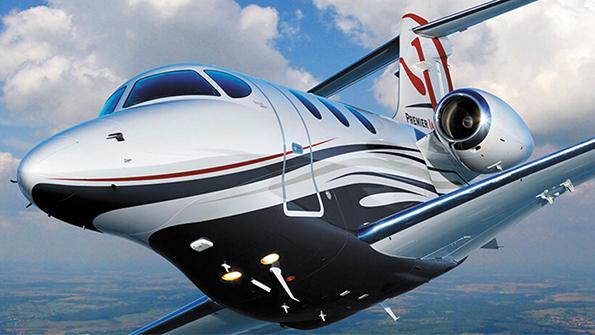
Speed, cabin room and price are three good reasons to consider the Premier 1A, if you’re in the market for a light jet, says Gavin Woodman, co-founder of Aerocor, a business aircraft brokerage based in Los Angeles. The aircraft cruises as fast as 450 KTAS and it offers a cabin cross-section nearly as large as that of the Citation Excel.
Hawker Beech manufactured 163 units between 2005 and 2011; there are 156 aircraft still in operation and 21 are for sale. With more than 13% on the market, asking prices of $1.3-2.1 million are soft, says Woodman.
The second-generation Premier 1A is much improved over the original model produced between 2001 and 2005. Braking feel and response is considerably improved, the lift dump function is manually controlled, the flight deck is upgraded with dual PFDs, standard IFIS and TCAS II. The IFIS supports electronic charts and XM satellite radio weather graphics.
Perennially cash-strapped Hawker Beechcraft was late in offering a WAAS GPS upgrade for Premier 1A., even though it is essential to support ADS-B Out. S.N. 282 and subsequent aircraft have the upgrade, but it’s available for earlier aircraft. The aircraft’s TDR-94 transponders also need updating or replacement to meet the ADS-B requirement. LPV approach is offered as another upgrade. Elliott Aviation offers a dual Garmin GTX-3000 Mode S transponder kit with GDL-88 data link and FlightStream 110 that provides both ADS-B IN and OUT functions.
Aircraft typically are fitted with a four-seat center club section, plus two chairs in the aft cabin. The main seating area is 11.2 ft. long, about the same as that of a CJ2. There is forward, right-side refreshment center and a fully enclosed, full-width 2.3-ft.-long aft lavatory. There is a 10-cu.-ft. baggage compartment in the nose and a heated, 40-cu.-ft. baggage compartment in the aft fuselage.
Premier 1A has a redesigned interior, offering increased rear-seat legroom and more overall headroom. Better acoustical insulation sops up more sound, but the aircraft isn’t the quietest in class. The interior has more comfortable cabin chairs than its predecessor, along with higher quality cabinets and more IFE options.
Weight gain has been the bane of Premier 1A. The 212-sq.-ft. wing and 2,300-lb- thrust Williams FJ44-2A engines are undersized for a 12,500-lb. aircraft. Typically, single-pilot BOWs are close to 8,600 lb. Thus, tanks full payload is 320 lb.
Premier 1A aircraft have pleasing handling qualities with the solid feel of a midsize jet, but with the crisper control response of a light jet. It has some midsize aircraft systems, such as a 3,000-psi hydraulic system that powers the spoilerons, landing gear actuators and wheel brakes. A rather cumbersome spoiler system check, though, is required before taxi. The aircraft has only one engine fire extinguisher bottle, a semi-automatic pressurization controller, short-travel, straight-leg landing gear and an annunciator light panel rather than a full EICAS.
Airport performance is not best in class. You’ll need 3,792 ft. of runway to depart from a sea-level, standard-day airport and 6,888 ft. when departing BCA’s 5,000-ft. elevation/ISA+20C runway. Even so, the aircraft can fly four passengers 1,100 nm. Operators say they are more comfortable flying 1,000 nm legs.
Loaded to MTOW, the aircraft will climb directly its 41,000-ft. service ceiling even at ISA+10C. But such warm-day conditions will knock 20 kt.off of max cruise speed as well as reduce range performance.
Operators love the aircraft’s speed, but most say they need as much as one more hour of range. The 400-plus-nm boost would enable them to fly between the U.S. coasts virtually every day of the year with one fuel stop. It also would enable them to fly nonstop from New England to Florida in the winter.
Pilots say they plan on burning 1,200-1,300 lb. the first hour, 820 lb. the second hour and 900 lb. during the final hour of most high-speed cruise missions, assuming standard-day conditions. Slowing down to long-range cruise adds up to 11% in travel time, but increases range by less than 100 nm. Budget fuel consumption at 154 gal./hr., says Woodman.
Maintenance tasks are relatively easy. There are comprehensive line service and lube inspections at 200-hr. interval,, A checks at 600 hr. and B checks at 1,200 hr. There are also some calendar required inspections. Williams’ TAP Blue runs close to $300-340 for both engines.
The Citation CJ2 and Nextant 400XT/XTi are the Premier 1A’s main competitors. The CJ2 has considerably better airport performance and it can fly four passengers more than 1,500 nm. But it’s 30-40 kt. slower, has a smaller cabin cross-section and it’s up to $1 million more expensive. Nextant 400XT also has a tighter cabin, albeit with a flat floor. It will fly 1,800 nm, and it has considerably sportier runway performance.
So, if you’re looking for a roomy cabin, comparatively high cruise speeds and excellent fuel efficiency, Premier 1A has appeal. Just mind the runway performance and tanks-full loading limitations when planning your trips.





